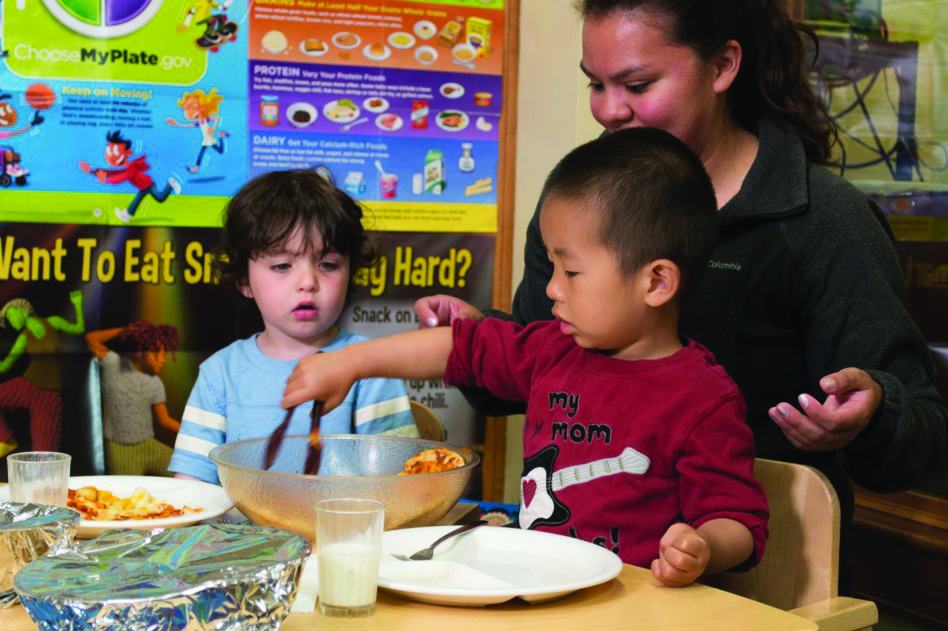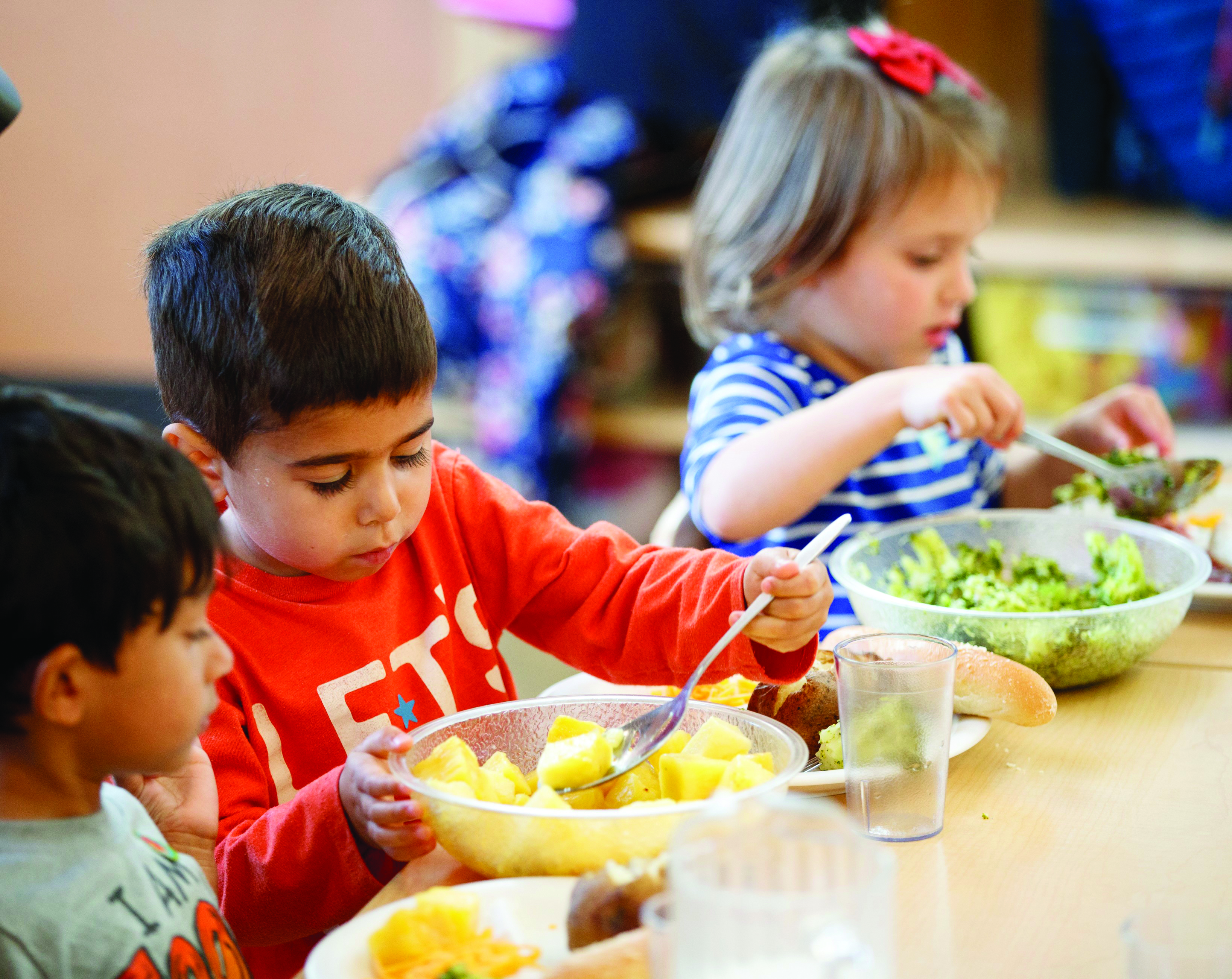

Jessie Peter, Extension Research Graduate Assistant
Aileen S. Garcia, Extension Research Graduate Assistant
Dipti A. Dev, Assistant Professor and Child Health Behaviors Extension Specialist
Zainab Rida, Team Nutrition Project Leader
This NebGuide aims to provide childcare providers with information about feeding practices from a culturally responsive perspective. Specifically, the authors offer direct strategies to promote cultural sensitivity and inclusivity of feeding practices.
In recent years, the demographic composition of the United States has changed considerably. With dramatic increases in ethnic minority and migrant populations, the U.S. is continuing to reflect a more ethnically diverse and culturally heterogeneous society. In Nebraska, Hispanics and Latinos comprise the biggest ethnic minority population, followed by African-American, Asian, and others. According to the Nebraska profile of Minority Population Report (2007, 2010), the overall minority population has increased from 15.5 percent to 17.9 percent (i.e., 275,059 to 326,915) and the number of children from ethnically diverse backgrounds younger than age 5 has also significantly risen (31,868 to 40,601).
The changing demographic landscape has numerous implications for childcare providers (CCP) who care for children and engage their families (e.g., childcare centers, family childcare homes, school administrators, child caregivers, and teachers). In order to be responsive to clientele, CCPs’ practices related to health-related issues need to be culturally responsive and sensitive to the backgrounds of those they are serving. Providers need to develop cultural competence, including knowledge and skills to provide effective programs and services to address the needs of different ethnicities and promote children’s healthful development. In this publication, families and CCPs are referred together as caregivers.

Caregivers want to provide children with good nutrition. They prepare foods that children like, try to accommodate requests, encourage children to eat new foods, fruits, and vegetables, and want children to be healthy. Although caregivers generally share the same goal of supporting the healthy development of children, some caregivers may be inclined to use controlling practices that seem straightforward but are harmful to promoting children’s health. Examples of such controlling practices include giving children food as reward, pressuring children to eat or clean their plate, finishing a healthy food before allowing dessert, and restricting unhealthy foods. Such practices may seem effective in the short term to get children to eat or try new foods, but they tend to have negative long-term implications.

Pressuring or rewarding children to eat different food may lead to negative eating behaviors, including disliking the food in the long term, becoming fussy, and developing weight issues (e.g., “If you drink milk, mommy will be happy,” or “If you eat salad, then you can have dessert.”). These practices also undermine children’s ability to self-regulate or their ability to eat when they are hungry and stop eating when they are full. On the other hand, modeling eating healthy foods to children and making fresh fruits and vegetables available and convenient in the household may increase the chances that children will eat healthy foods.
Many factors shape caregivers’ beliefs and practices about feeding, and it is important to remember that caregivers of different cultures follow different food-related beliefs. The first step in using culturally responsive feeding practices is to recognize one’s own cultural beliefs regarding feeding.
The next and equally important step for CCPs is to be aware of the cultural practices of the families they work with. It is important to remember that parents typically try to raise their children according to the values, beliefs, and customs accepted by their ethnic practices and groups, even if they are sometimes incompatible with mainstream American culture. For instance, among Asian Americans, studies show that a parent’s childhood experiences, the husband’s food preferences, and lenient grandparents influence the choices of food served at home.

Controlling feeding practices, such as pressuring children to eat or finish their food or using food as a reward, are also present across cultures. These practices may be driven by the parents’ desire to promote the children’s liking of traditional foods. Parents also may train their children to eat all of the food on their plates to prevent food waste in the household, as a sign of respect for those who experience food insecurity. For families, pressure to eat and food restrictions often are driven by limited parent nutrition knowledge. For example, caregivers may have the tendency to incorrectly categorize children’s weight, such as classifying a child with high BMI Body Mass Index (BMI) as simply chubby or cute. Additionally, in some cultures, being overweight or obese may be considered a sign of good health and representing wealth, and thus may be viewed as an ideal weight. To ensure that children consume adequate and healthy foods, parents pressure them to eat. Some parents of various ethnicities also tend to believe that children say they are full only to avoid eating.

Parents and other adult caregivers in the family may restrict certain foods due to religious affiliations. Those who follow Islam, for example, do not eat pork and may only eat meats that are halal, foods allowed under Islamic dietary laws. Believers of Hinduism do not consume beef. They may restrict their children’s eating of these food items, similar to Jews who may only eat kosher foods. Families from these cultures may also observe fasting for a period of days or weeks because of religious traditions.
Research shows that families widely differ in their feeding practices and mealtime routines based on their cultural practices. CCPs can benefit from having this knowledge as they work with families from varied cultural backgrounds. Along with this knowledge, parents and CCPs can use different culturally responsive feeding strategies to encourage healthy eating habits among children. These include the following:
Understand that feeding practices are viewed differently among cultures and that these practices may be deeply rooted in personal experiences, cultural beliefs, parenting norms around socialization, and child expectations. Traditional practices often perceived favorably in one’s home culture may be considered good for the children. However, a practice that may be a way of showing affection in one culture may appear as pressuring the child in another. For example, a verbal comment by the caregiver, “You are not eating your food, please have some more” can be perceived differently based on the observer’s frame of reference. Therefore, it is critical to be sensitive to different cultural practices. This can be accomplished by making an effort to understand the reasons behind these practices by asking questions before making recommendations. For example, CCPs should ask parents what they mean when they say that their children cannot eat animal products because they are not halal. In addition, they need to make families aware that they offer fish, eggs, cheese, yogurt, and legumes that are halal products. This will ensure a clear route of communication between CCPs and families and can help children receive a balanced diet.

To reflect healthy feeding practices, child caregivers can reframe what they say to elicit healthy child eating behaviors as well as accommodate cultural preferences. The following table lists some examples of positive feeding practices.
Caregivers (families and CCPs) should consider having family meals where all adults and children sit and enjoy eating the same foods together. This practice can result in a pleasant mealtime and improve children’s acceptance of new foods. Moreover, shared mealtimes provide an excellent opportunity for adults to model healthy eating habits to children.
During mealtime, caregivers and children are encouraged to implement the division of responsibility. Specifically, the caregivers’ responsibility is to decide what, when, and where the food is provided. The children’s responsibilities are to decide how much, what, and whether to eat while recognizing their hunger and fullness. Following this division of responsibility helps to build trust between the caregivers and children. Caregivers should provide a structure of the feeding environment while avoiding use of controlling feeding practices with children.
As the primary decision-makers, caregivers should be conscious of the food environment, specifically the foods they make available to children. Buy more vegetables and fruits and avoid stocking up on high-sugar, high-fat foods. Identify and suggest ethnic stores in the community where healthy ethnic food options are available.

Caregivers need to work together in preserving and promoting the home culture by identifying healthy options within the parents’ or the family’s home culture. Build on family feeding goals by enhancing their knowledge of the dietary guidelines and portion sizes. Also, make culturally relevant suggestions and provide recipes for balancing convenience, nutrition, and variety. This can be achieved by providing nutrition education materials.
Caregivers are encouraged to practice alternative ways of displaying affection instead of giving food as a reward or placing excessive restrictions on what and how much children can eat. For example, spend quality time with the children by investing in reading books, visiting a library, zoo, or park, or dancing together to a favorite song.
Caregivers are encouraged to not only ensure that their children are healthy, but also to be mindful of their own health. They should adapt healthy food-related practices and engage in physical activity. Children mimic adults so when they see adult caregivers trying a variety of foods, they will be more likely to try them as well.
In all cultures, the whole family, including grandparents, influences children’s eating habits. Therefore, CCPs should communicate healthy feeding practices not only to the mother, but also to the father and the rest of the family. Doing this will increase awareness of the recommended practices for feeding children.
Awareness of our own and other’s ethnic beliefs, values, and customs is very important for CCPs. When CCPs are reflective and intentional of their feeding practices and understand the family’s cultural influences in shaping feeding practices, they can develop a respectful relationship. They can work together towards a common goal of ensuring that children develop healthy eating habits. Families and CCPs share equal responsibility in shaping healthy eating behaviors in children. Parents, grandparents, or other adult caregivers should communicate in detail with CCPs about their child or children’s dietary behaviors.
If you would like more information about culturally responsive feeding practices, additional resources that child caregivers (parents and childcare professionals) can use include:
Zhang Anthony. Racial/ ethnic minority population growth, state of Nebraska. Department of Health and Human Services. 2009.
Zhang Anthony. Profile of the minority population in Nebraska. Department of Health and Human Services, Nebraska. 2015.
Roche A, Goto K, Zhao Y, Wolff C. Bonding and bridging social and cultural capitals: Perceived factors associated with family eating practices among Hmong, Latino, and white mothers and fathers. Journal of Nutrition Education and Behavior. 2015;47(6):547.e1.
Powers SW, Chamberlin LA, Schaick KB, Sherman SN, Whitaker RC. Maternal feeding strategies, child eating behaviors, and child BMI in low-income African-American preschoolers. Obesity. 2006;14(11):2026–2033.
Elford L, Brown A. Exploring child-feeding style in childcare settings: How might nursery practitioners affect child eating style and weight? Eating Behavior. 2014;15(2):314–317.
McBride BA, Dev DA. Preventing childhood obesity: Strategies to help preschoolers develop healthy eating habits. 2014.
Super CM, Harkness S. The developmental niche: A conceptualization at the interface of child and culture. International Journal of Behavioral Development. 1986;9(4):545–569.Garcia Coll C, Akiba D, Palacios N, et al. Parental involvement in children’s education: Lessons from three immigrant groups. Parenting: Science and Practice. 2002;2(3):303–324.
Mena NZ. Contextual and cultural influences on parental feeding practices and involvement in child-care centers among Hispanics. 2015;11(4):347–54
Momin SR, Chung KR, Olson BH. A qualitative study to understand positive and negative child feeding behaviors of immigrant Asian Indian mothers in the US. Maternal Child Health J. 2014;18(7):1699–1710.
Slusser W, Erausquin JT, Prelip M, et al. Nutrition knowledge and behaviors of low-income Latino parents of preschoolers: Associations with nutrition-related parenting practices. Early Child Development and Care. 2012;182(8):1041–1055.
Slusser W, Erausquin JT, Prelip M, et al. Nutrition knowledge and behaviors of low-income Latino parents of preschoolers: Associations with nutrition-related parenting practices. Early Child Development and Care. 2012;182(8):1041–1055.
Sherry B, McDivitt J, Birch LL, et al. Attitudes, practices, and concerns about child feeding and child weight status among socioeconomically diverse white, Hispanic, and African-American mothers. J Am Diet Assoc. 2004;104(2):215–221.
Maynard LM, Galuska DA, Blanck HM, Serdula MK. Maternal perceptions of weight status of children. Pediatrics. 2003;111(Supplement 1):1226–1231.
Fletcher J, Branen L. Feeding young children in group settings. 2000.
Eneli IU, Tylka TL, Hummel J, et al. Rationale and design of the feeding dynamic intervention (FDI) study for self-regulation of energy intake in preschoolers. Contemporary Clinical Trials. 2015;41:325–334.
Darling N, Steinberg L. Parenting style as context: An integrative model. Psychology Bull. 1993;113(3):487.
This publication has been peer reviewed.
Nebraska Extension publications are available online at http://extension.unl.edu/publications.
Extension is a Division of the Institute of Agriculture and Natural Resources at the University of Nebraska–Lincoln cooperating with the Counties and the United States Department of Agriculture.
University of Nebraska–Lincoln Extension educational programs abide with the nondiscrimination policies of the University of Nebraska–Lincoln and the United States Department of Agriculture.
© 2018, The Board of Regents of the University of Nebraska on behalf of the University of Nebraska–Lincoln Extension. All rights reserved.